Key Takeaways: 2025 Giro d'Italia Stage 20
Attempting to make sense of one of the most thrilling, and baffling, mountain stages in modern Grand Tour history
After simmering on a low boil for nearly three weeks, the fight for the General Classification at the 2025 Giro d’Italia exploded on the slopes of the monster Colle delle Finestre. Simon Yates, on the exact same climb where his Giro dreams famously imploded in 2018, rode clear of Isaac del Toro and Richard Carapaz, who were locked in a baffling and petty battle behind, while, just like Chris Froome did to him seven years ago, Yates floated away to complete a stunning come-from-behind victory and produce one of the most thrilling mountain stages in the last few years of the Giro.
After the literal dust settled on a stage framed by the grandeur of the Italian Alps, Simon Yates came in two minutes behind stage winning Chris Harper, who got his first European race win, but over five minutes ahead of his GC rivals, meaning he enters tomorrow’s final stage with near-four minute GC lead, and on the cusp of delivering a dramatic, and a poetic, Grand Tour turnaround.
Check out the blow-by-blow breakdown, select power analysis, and the key takeaways of Stage 20 below:
Stage Top Five:
1) Chris Harper (Jayco AlUla) +0
2) Alessandro Verre (Arkéa-B&B Hotels) +1:49
3) Simon Yates (Visma-Lease a Bike) +1:57
4) Gianmarco Garofoli (Soudal Quick-Step) +3:52
5) Rémy Rochas (Groupama-FDJ) +3:57
Time Top Five GC Contenders Gained(+)/Lost(-) On Stage 20:
S. Yates +0
Del Toro -5’17
Gee -5’17
Caruso -5’17
Carapaz -5’21
GC Top Ten:
1) Simon Yates (Visma-Lease a Bike) +0
2) Isaac del Toro (UAE Team Emirates-XRG) +3:56
3) Richard Carapaz (EF Education-EasyPost) +4:43
4) Derek Gee (Israel-Premier Tech) +6:23
5) Damiano Caruso (Bahrain-Victorious) +7:32
6) Giulio Pellizzari (Red Bull-BORA-hansgrohe) +9:28
7) Egan Bernal (INEOS Grenadiers) +12:42
8) Einer Rubio (Movistar) +13:05
9) Brandon McNulty (UAE Team Emirates-XRG) +13:36
10) Michael Storer (Tudor Pro Cycling) +14:27
Stage 20 Race Notebook
BTP is seamlessly following every twist and turn of the Giro d’Italia with the fantastic Tour Tracker app (iPhone/Android/Web)
135.9km-to-go: A massive early breakaway gets clear while the peloton slows up in anticipation of the brutal climb awaiting them later in the race. One notable rider in the move is Visma’s Wout van Aert, who is clearly up here in an attempt to get over the Finestre to help Simon Yates pass in the valley for the final climb to Sestrière. But, instead of marking this as a concern and trying to either get their own riders up here, or keep the break on a tight enough leash that Van Aert is caught on the Finestre, UAE lets the move build up a massive advantage.
41.9km: At the base of the Finestre, the breakaway has a gap of nine minutes. Richard Carapaz’s EF team does a full-on sprint leadout, which explodes the peloton and catches out the other GC contenders.
41.9km cont: With Carapaz getting ready to launch a full-out sprint, Isaac del Toro, who is still in the wheel of a teammate, panics and goes to chase Carapaz down, at the bottom of an hour-long climb, by himself. Meanwhile, Simon Yates stays back with the peloton with Derek Gee.
41.9km-41.3km: With his EF team already fried, Carapaz attacks, and Del Toro, who is now completely isolated from his team, follows him.
40.1km: With Carapaz already constantly attacking Del Toro, who is sitting on the wheel and refusing to work, Simon Yates takes advantage of the on-off pace and bridges up to them using a measured, steady pace.
38.7km: Realizing Carapaz and Del Toro are single-mindedly focused on each other, with Del Toro only following Carapaz’s attack, not his, Yates lays down a solid attack and gets clear with a small gap after both Carapaz and Del Toro refuse to chase.
38.6km: Carapaz and Del Toro only begin to mount a chase on Yates when Derek Gee, who recognizes you can’t cheat an hour-long effort, is riding at a steady effort and catches Carapaz and Del Toro.
37.2km: Carapaz attacks again, but, even though he gets close to Yates, he sits up, attempting to force Del Toro to close the rest, but, when he doesn’t, the gap begins to go out again.
34.2km: With Carapaz and Del Toro still not focused on Yates and riding a start-stop pace due to Carapaz constantly attacking, Yates’ steady riding has allowed him to quickly build up a minute’s advantage, meaning he is almost already in the virtual race lead.
29km: Even after Yates’ lead hits nearly two minutes, meaning he is in the virtual race lead by 38 seconds, Del Toro is still sitting on Carapaz’s wheel and refusing to work.
23.4km: When Del Toro finally starts pulling near the top, Yates’ lead has come down. He crests the summit with 1’41 on the chasers and is in the race lead by 20 seconds.
19.6km: Van Aert sits up on a flatter section of the descent, allowing Yates to catch him and settle into his slipstream.
17.1km-10.6km: With Van Aert pulling all out on the front through the valley while Del Toro soft-pedals after Carapaz refuses to pull through, the gap grows by 26 seconds, meaning Yates has a virtual race lead of 1’02 when he hits the final climb to Sestrière.
9.5km: However, as Yates bursts clear of Van Aert, Del Toro appears to completely throw in the towel, nose-breathing as Carapaz remains on his wheel as the gap increases by almost half a minute in just a kilometer. It looks incredibly odd, since he is still technically able to rescue his race lead with a fast climb to the finish line, but he is clearly terrified at the prospect of Carapaz attacking him and taking his second place overall.
Finish: Jayco-AlUla’s Chris Harper from the early breakaway, holds off the chasers to win the biggest race of his career, while Simon Yates comes in nearly two minutes later, putting over five minutes to the rest of the GC contenders and certainly sealing the overall win.
Three Key Stage Takeaways
1) Simon Yates’ Stunning Comeback Resulted From Smart Racing & Career-Best Climbing Day: Setting aside the storybook completion of his Finestre and Giro d’Italia circles, Simon Yates’ ride to take control of the overall lead of this Giro d’Italia boiled down to an ability to solve a series of simple logic tests and having amazing legs at just the right time.
For example, at the base of the toughest climb in the race, Yates realized that going above his threshold power to respond to the near-sprint efforts of Richard Carapaz and Isaac del Toro was a fool’s errand, and simply rode his own pace to get back to them after they were locked into a duel.
This was the right move since, on an hour-long climb, going above your threshold power (the power you can ride for one hour) for too long won’t actually result in a rider clocking a faster time, since your max effort is capped, and you are better off spreading it out equally.
And, once he got up to the two biggest GC contenders, Yates quickly realized that Del Toro’s full attention was on Carapaz, not him, and that the two riders would have a hard time chasing him if he got even a slight gap.
Once Yates invested just a small amount of energy to get ahead of the two, he likely knew that he could net a much faster time due to riding a one-speed steady pace while they wouldn’t be able to break out of their start-stop attacking efforts, which would see them end up riding a much slower time.
While these are relatively easy conclusions to come to, Yates’s effort to pull it off was anything but ordinary.
Yates set the all-time record time on the 18-kilometer-long Finestre, ripping up the 9% average grade in 59 minutes, 22 seconds, nearly five minutes faster than Chris Froome when he rode clear of a Maglia Rosa-clad Simon Yates on the same climb in 2018.
I calculated that this effort required Yates to average roughly 360 watts, or 6.2 watts per kilogram, for nearly an hour, with the top half of the climb taking place over 2,000 meters (6,500 feet).
For comparison, Tadej Pogačar averaged roughly 418 watts, or 6.4 watts per kilogram, for the shorter 45-minute Monte Grappa, on Stage 20 of last year’s Giro.
Taking the longer duration and higher altitude of Finestre into account, this effort holds up incredibly well against an all-time great and highlights that this was one of the best performances of Yates’ career.
2) Visma-Lease a Bike’s Superior Tactics Gave Yates a Significant Advantage: While Yates’s individual effort was incredible, he had a massive boost, both real and psychological, due to the far superior tactics of his Visma team.
With the rest of the GC teams sitting back and racing the day from behind, Visma got proactive, sending Wout van Aert in the breakaway.
This was key since with the breakaway starting the climb with a nine minute advantage, Van Aert would be waiting in the valley on the other side, meaning Yates would have a big powerful slipstream waiting for him if he needed to either hold off a chasing group, extend a gap, or chase back on, after the Finestre.
The reason this was so important today is the fact that with an hour-long climb, there was little chance teammates, even super domestiques, would be able to make it over the climb with the GC group.
And, even if they were in or close to the group, the consistently steep gradients would mean that any teammate pacing is likely to be slower than a top GC contender, so sitting on their wheel or waiting for them to catch up would just cause a leader to lose time.
So, once it was clear Van Aert was waiting for Yates on the other side of the Finestre, there was little chance for Del Toro or Carapaz to contain the gap since they had no prospect of receiving any pacing help from teammates.
With this in mind, Wout van Aert, who still had to produce 400 watts for an hour (5.2 w/kg) to get over the climb ahead of Yates, is truly a kingmaker.
In every Grand Tour he has raced where a teammate has won, he has played a massive role with pacing on mountain stages, which is hugely impressive for a superstar Classics rider who outweighs most climbers by 20 kilograms and could easily eschew the responsibility.
3) Isaac del Toro & Richard Carapaz Lost the Giro Due to a Single-Minded Focus on One Another: Simon Yates might have ridden the climb of his life while his tactically superior Visma team ran circles around their competitors, but none of this explains the mind-boggling behavior from the former race leader Isaac del Toro.
Looking at how Carapaz’s early attack caused him to panic and respond too quickly, leaving his teammates behind and causing him to go far too deep, it is clear that Del Toro was extremely focused on marking the rider within a minute of his lead.
This meant Del Toro wasn’t focused nearly enough on Simon Yates, or didn’t fully grasp that he was only 1’21 back coming into the stage, and that as race leader, it was his responsibility to defend the lead at all costs.
Once it was clear Yates was riding up the road and close to taking the virtual race lead, Del Toro’s first priority should have been to get to the front and ride at his aerobic limit to stem his losses on the climb.
He may have been afraid of Carapaz attacking him, but this became less of a concern later in the climb, since, with Yates so far ahead, Carapaz wouldn’t have wanted to be caught alone in no man’s land if Del Toro showed a willingness to set a hard pace with him.
Also, he came into the stage with a 43-second buffer, and a steady pace would have allowed him to limit the gains Carapaz could take by the top of the climb.
Not to mention that by that point, an attack from Carapaz should have been less of a concern than Yates riding away with the victory.
But, even if Del Toro’s climb of the Finestre left something to be desired, his complete ambivalence to closing the gap to Yates in the valley and on the final climb, when he only needed to pull back 30 seconds to Yates to retake the race lead, going so far as to sit up and free-wheel at multiple points, was one of the strangest things I’ve ever seen at the pointy-end of a top-level professional bike race.
While it is possible he was fatigued and was rightfully thrilled to take second place in a Grand Tour at just 21 years old, his nose-breathing and powerful sprint to the finish line showed that he had plenty left in the tank.
Perhaps we will never fully understand what happened between Carapaz and Del Toro, both of whom seemed happy to lose at the expense of the other, but it reminded everyone yet again that becoming solely focused on a rival in a three-week race can become a dangerous obsession that allows others to spring clear and take the win (which is ironically how Richard Carapaz won the 2019 Giro).
Stage 21 Preview
Tomorrow’s stage serves up a largely ceremonial circuit race in Rome, which is almost sure to end in a bunch sprint.
Prediction: Olav Kooij continues Visma’s dream Giro by winning the final stage off a leadout from Wout van Aert.

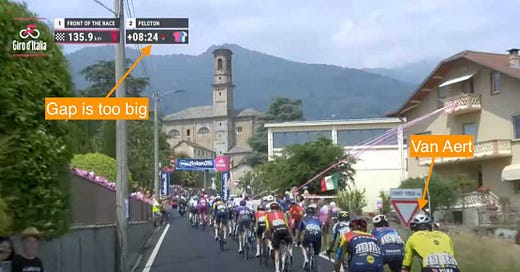




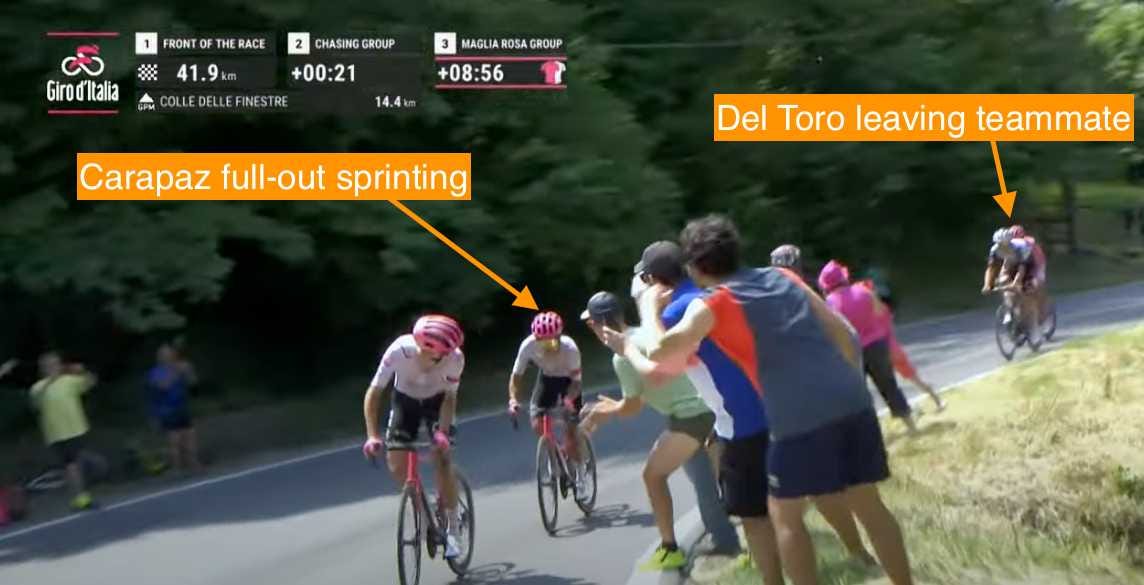
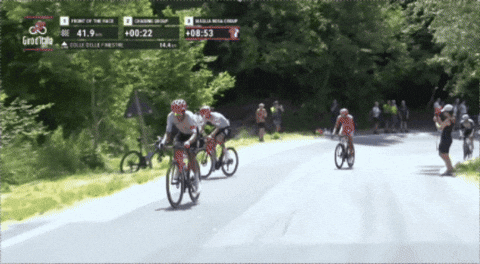
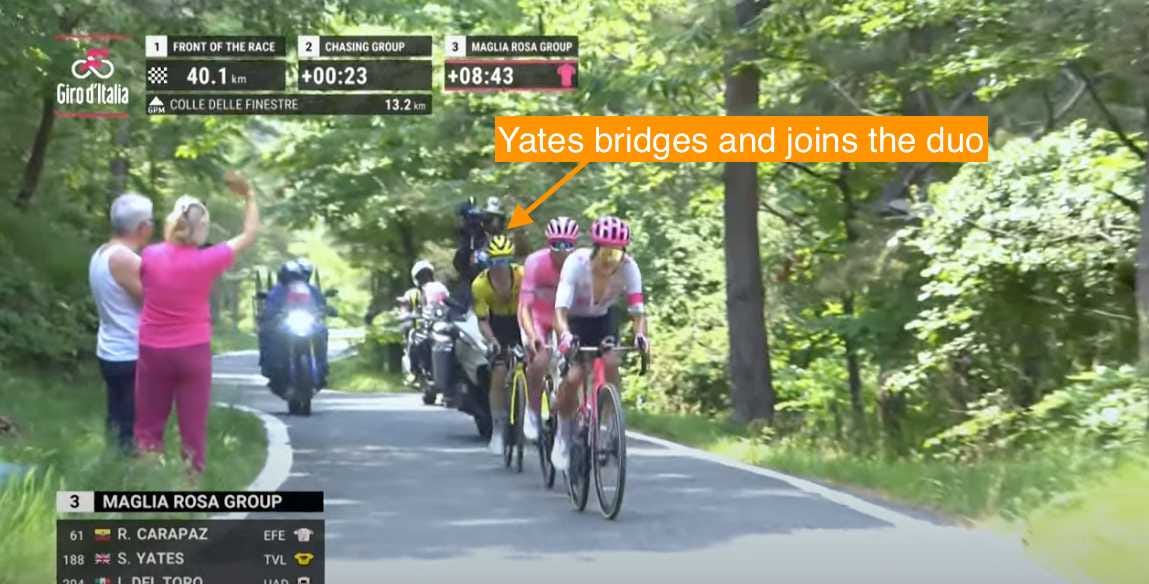

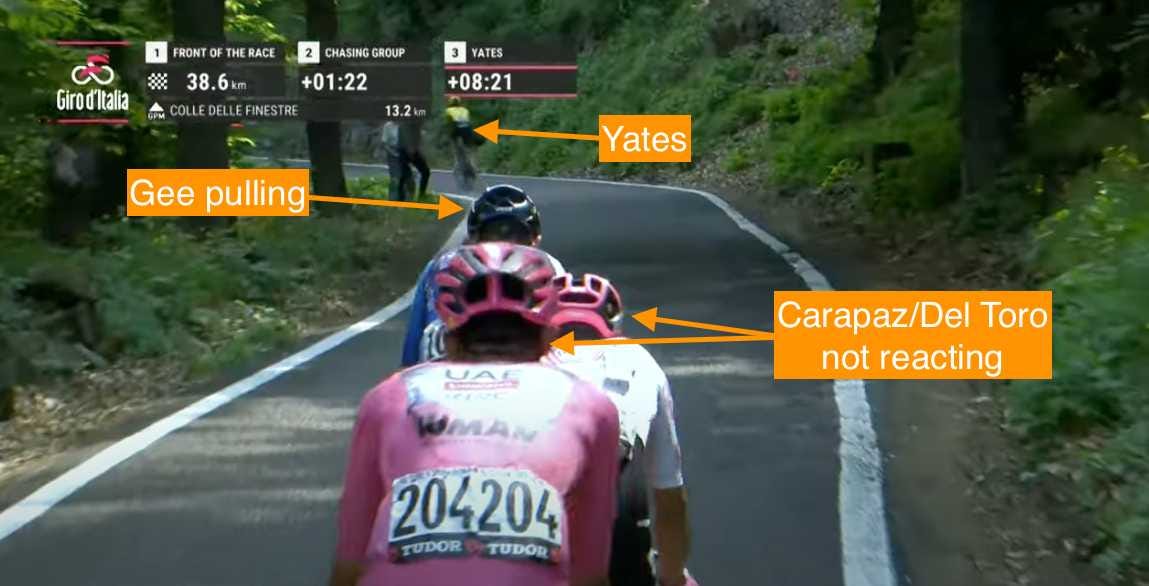
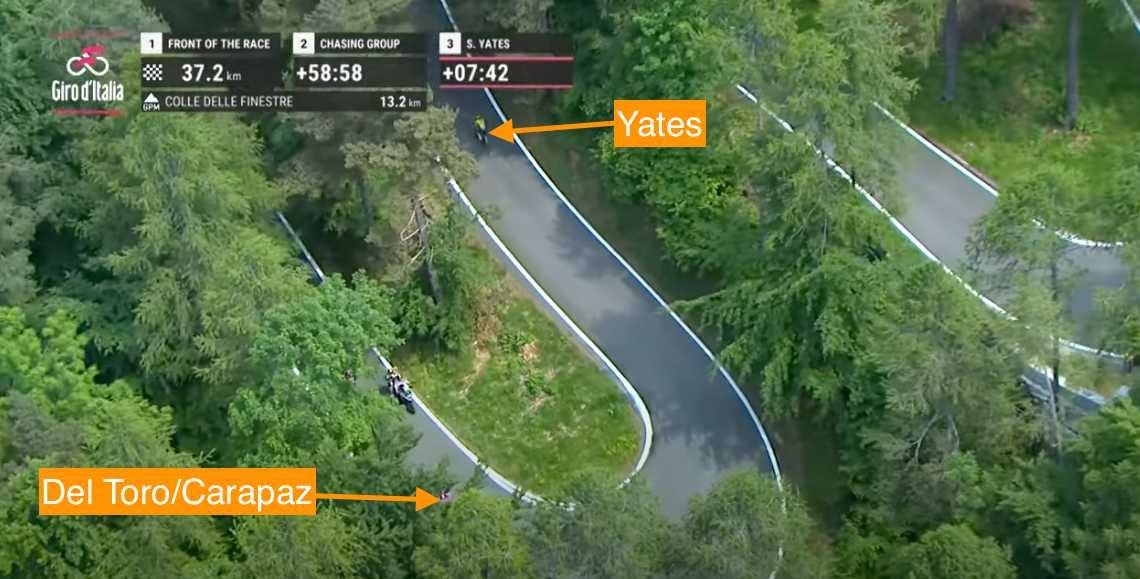

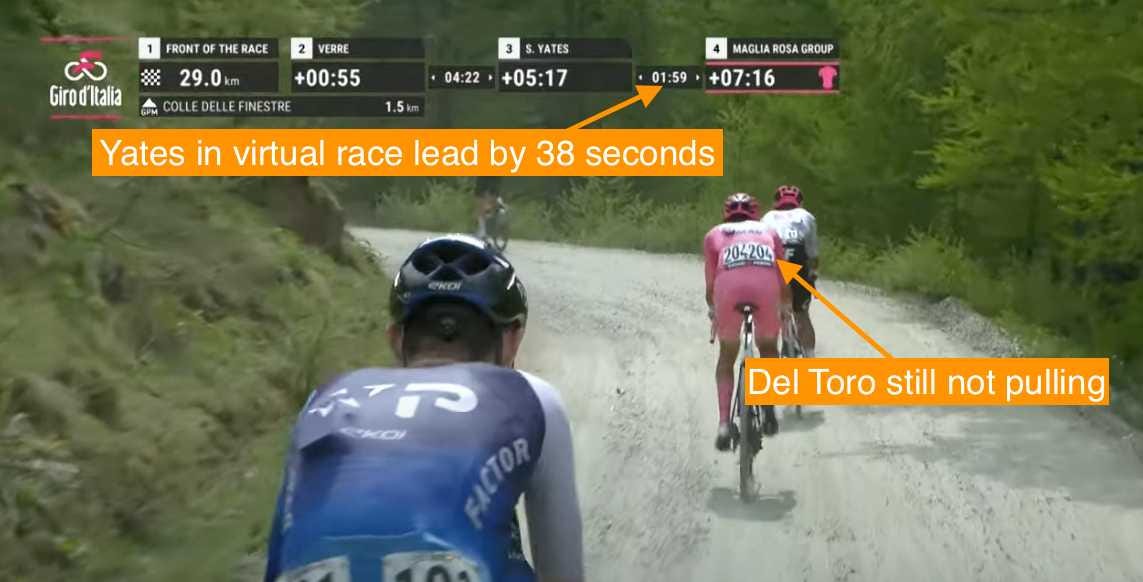
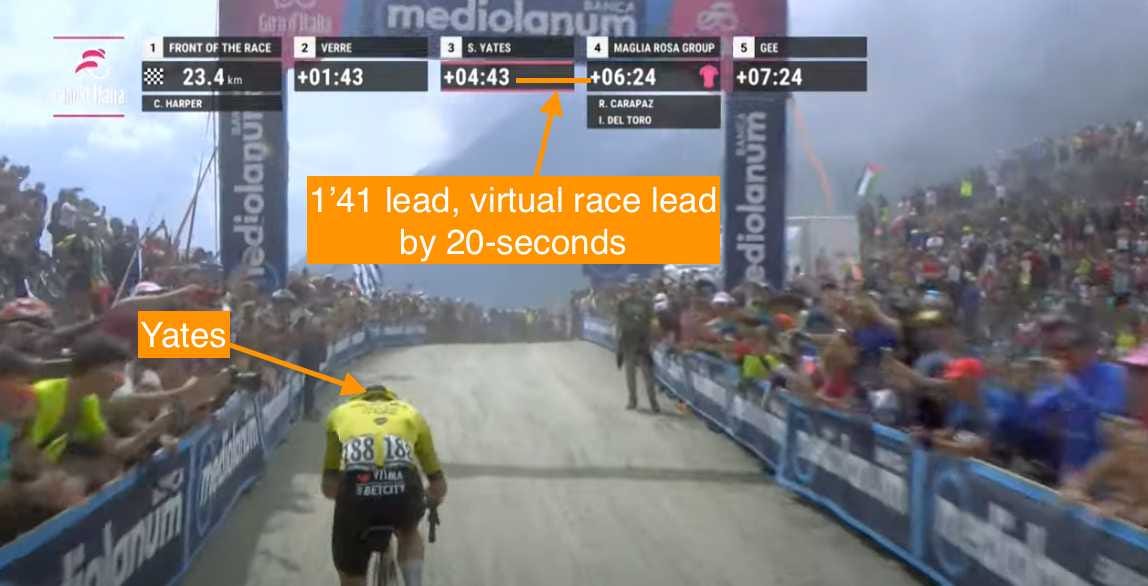


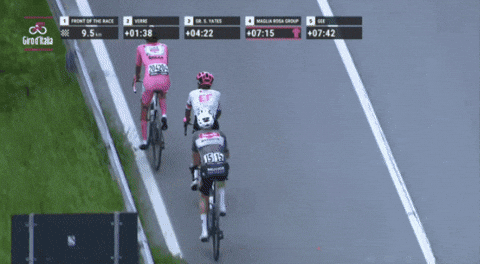


I secretly hoped that Yates was sitting back, biding his time, conserving his energy, but it seemed unlikely at best and I’ve been let down many times by such irrational hope… It was pretty awesome to see it true! And then Wout, so fun that even the announcers couldn’t seem to find anyone that knew exactly where he was to have him emerge at the perfect time, in the perfect spot… after Yates had surely emptied the tank in that effort conquering his old nemesis Finestre, the rendezvous with his loyal and capable teammate to shepherd him safely most of the rest of the journey… its hoakey sounding but it’s storybook stuff
How and why in the world would the sports Director in the UAE car not have told Del Toro to at least moderately chase Yates to win a grand tour.
Unbelievable and ought to lose his job.